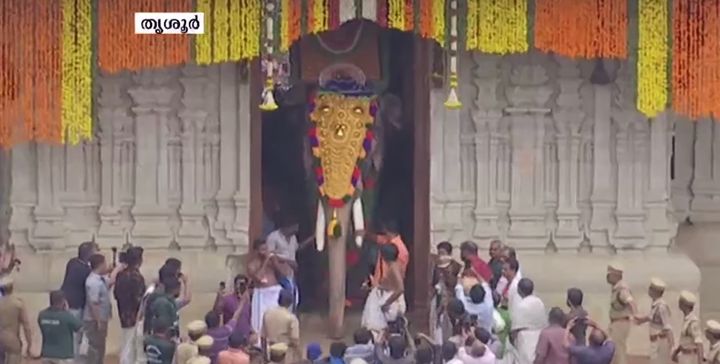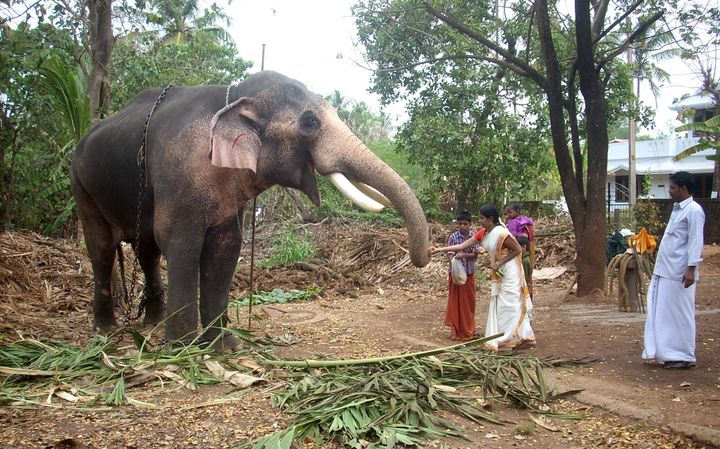
Kerala’s celebrity elephant, Thechikottukavu Ramachandran, entered the Vadakkumnathan temple in Thrissur on Sunday amid huge fanfare after a ban on the tusker was lifted temporarily.
Ramachandran was permitted to participate in the temple’s Vilambaram ceremony for an hour after initially being barred from taking part in any temple events by the district collector.
The ban on Ramachandran, ahead of Thrissur Pooram, one of Kerala’s biggest festivals, had led to uproar and protests by the state’s elephant owners association.
Thrissur Pooram, which begins on Monday, 13 May, is attended by lakhs of people every year.
Who is this celebrity elephant?
Thechikottukavu Ramachandran is India’s tallest captive elephant and is 54 years old. He was once named Moti Prasad and came to Bihar from forests in Assam forests. He was named Ganeshan when he came to Thrissur.
In 1984, the Thechikkottukavu Devaswom bought him from Venkidadri Raju Narayanaswami and renamed him Thechikottukavu Ramachandran, Malayala Manorama reports.

Why is he important?
In recent years, the Thrissur Pooram festivities have begun with Ramachandran symbolically pushing open the southern entrance gate of the ancient Vadakkumnathan temple.
On Sunday morning, Ramachandran received the Naythalakkavu Bhagavathy idol from another elephant Devidasan. He was then paraded to the temple as he carried the idol to the temple, Mathrubhumi reported. As part of the temple festival’s Pooram vilambaram ceremony, Ramachandran paid obeisance to the temple’s presiding deity and opened its doors on the south side.
Watch the ritual below:
Why was he in the news?
Ahead of the Thrissur Pooram, the district’s collector had banned the elephant’s participation, a decision supported by the state’s forest minister K Raju.
In February, two people were killed after the elephant ran amok in Guruvayur, after firecrackers were burst near it. According the Malayala Manorama, the chief wildlife warden had then barred the elephant’s participation in temple events. However, the Kerala forest minister has said there is no ban on Thechikottukavu Ramachandran taking part in temple processions.
According to the Livemint, a task force that recently checked Ramachandran found he was almost blind and had problems with digestion.
State govt vs elephant owners
The Kerala Elephants Owners Federation said they would not provide elephants for any temple festivals from 11 May, Mathrubhumi reported, in protest of the ban on Thechikottukavu Ramachandran. They also ruled out any resolution with the authorities until the ban was recalled.
Kerala government assured everyone that the Thrissur pooram would be held in all its splendour, Devaswom minister Kadakampally Surendran said.
Ministers Kadakampally Surendran, Sunil Kumar and MLA KB Ganesh Kumar also held talks with representatives of the association.
Sunil Kumar said the elephant would be a part of an event of the festival for some time.
What did the high court say?
The Kerala High Court on Friday refused to interfere in a petition seeking to allow the jumbo to take part in the Thrissur Pooram festival, saying the authorities concerned should take a decision on the matter.
Justice Anu Sivaraman said a decision on allowing the tusker to participate in an important ritual related to the Pooram festival has to be taken by the authorities concerned.

What was final decision and who took it?
The Thrissur collector had on 9 May said that all elephants that run amok when crackers are burst and ones that are aggressive will be banned, effective 12-14 May.
After the uproar over Ramachandran’s ban, An expert committee led by the collector approved the elephant’s conditional participation in the temple’s vilambaram ritual for an hour.
The collector directed that the elephant be accompanied by four mahouts and that a 10-metre barrier is constructed to keep crowds from getting close to it.
How are elephants treated in Kerala?
Captive elephants are often not treated well. Elephants that participate in temple festivals are made to walk on hot, tarred roads and in processions with massive crowds and lots of noise.
UK-based Action for Elephants has called Kerala ‘ground zero for elephant torture’. According to a local group called Kerala Suffering Elephants, the mortality rate of the captive animal is shockingly high — 12 died in 2018, 58 had died in 27 months. Animal rights activist Venkitachalam told Livemint he had received death threats for advocating a ban on having elephants at temple festivals.
(With PTI inputs)